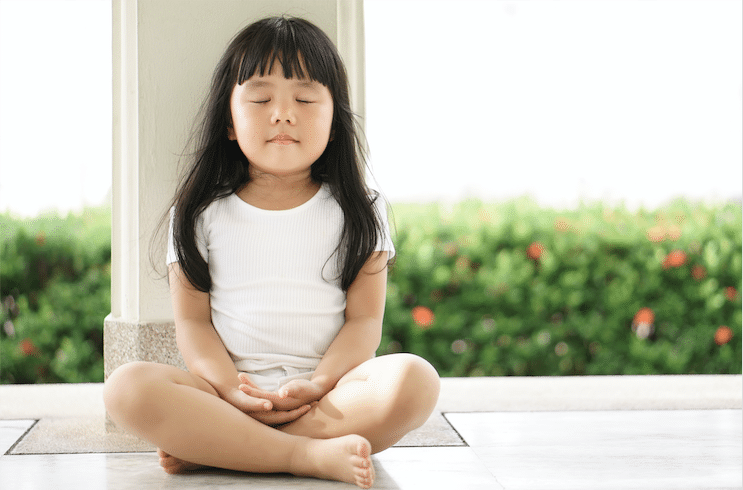
Kellie Cathey, LSW, Child and Family Play Therapist, explains the significance of mindfulness for kids and offers tips for families to employ proven techniques as part of their daily routine as anxiety in children seems to be on the rise.
Kellie facilitates a monthly workshop at our Center City office – Mindfully Me – that helps kids 6-10 years of age build confidence using relational and emotional coping strategies. Visit our website for more information.
Explaining Mindfulness to Kids
Mindfulness has become quite the buzz word, hasn’t it?
We can call it: deep breathing, paying attention on purpose, focusing on your breath to create space, becoming more aware of ourselves, breathing to become less reactive.
But how do we explain mindfulness to a six-year-old?
In my experience of teaching mindfulness to children, we don’t have to explain it. They already intuitively get it. Here are some ways I have heard children describe mindfulness:
- “Mindfulness makes my heart happy.”
- “Breathing makes me feel less nervous.”
- “Being mindful helps me be more present.”
- “Mindfulness makes me a better singer.”
- “I’m mindful when I’m playing!”
Children understand mindfulness in such a deep way because at the core of mindfulness is being present. Therefore, mindfulness helps children become more of what they are: present in the moment.
Mindfulness helps children come back to the present moment through learning deep breathing and becoming aware of their bodily sensations. Children are naturally wired to feel these things intuitively but it’s our job as the adults in their lives to help them foster these skills into adulthood.
Helping Kids Deal with Anxiety
For children who are more vulnerable to experiencing anxiety, using mindfulness as a regular practice helps these children stay grounded and aware of what they are experiencing internally. When children with anxiety learn to follow their breath and create space between themselves and their thoughts and feelings, they find that their fears are not as big a scary as the believe they are.
Helping your anxious child (or any child!) create space between themselves and their internal experience is so helpful for them to foster a sense of who they are outside of life’s challenging and scary moments. It helps build resilience and helps them feel bigger than the big fears life can bring us.
Teaching Kids Mindfulness
Mindfulness can be taught in small ways at first and that can make all the difference. Taking a moment to help your child breath through the scary times or ask them where they feel the scary in their body helps them build trust that they are bigger than the fears they feel.
Here are some small ways you can begin to help your child bring mindfulness into their body and being.
Belly Breath
Breathing deeply into our bellies calms the nervous system drastically. It helps us regulate our emotions and feel calm when our nervous system becomes heightened. Here’s how to begin!
- Practice Belly Breath with your child when you are both calm and relaxed. Practicing during calm times helps us to know what being relaxed feels like. Once it is mastered in relaxed times, your child can begin using it when they are stressed.
- Have your child lie on their back in a comfortable location. Tell them to relax their body and place their hands on top of their belly button.
- Slowly, tell your child to take a deep breath in so it fills their own chest and belly. Hold the breath for 3 seconds.
- Have your child slowly breathe out all the air until it’s gone. Repeat as many times as needed to feel calm.
Where Do You Feel It?
Helping children become aware of the sensations they are having in their body helps them know what their body needs to feel better. When your child is having a big feeling (like nervousness or sadness), trying to ask some of these questions to help them become aware of the feelings.
- Where is the feeling in your body?
- What does the feeling feel like? Is it tight? Hollow? Sharp? Heavy? Thick?
- If the feeling had a color, what would it be?
- What does the feeling need to feel better? A hug? Some tickles? A bath?
Helping your child work through these questions helps them to bring awareness to their feelings and what they may need to feel better.
Blow Bubbles
It sounds so simple, but it’s so effective! Blowing bubbles with an anxious child (or any child!) helps them focus on their breath AND have fun. Taking a break from homework or taking some time before going on a big trip to blow bubbles helps kids become more present in play and helps them regulate the big emotions they are having. And you get to have fun, too!
As we begin to use these skills at home regularly, you will see how your child begins to adapt naturally. Children (and all of us!) have an innate desire to feel good but sometimes life just feels too overwhelming for that to happen. Mindfulness helps keep our hearts happy enough to stay connected and feel the joy of life we all so deeply desire.
 33 Rock Hill Rd
33 Rock Hill Rd 1740 South Street
1740 South Street 2365 East York Street
2365 East York Street